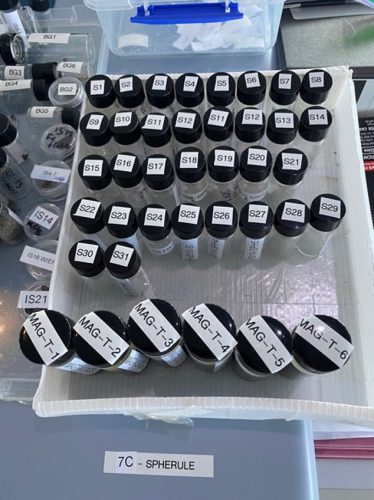UFO-hunting Harvard scientists say debris from unidentified object that crashed into Pacific Ocean in 2014 appears ‘artificial in origin’ – and they could be remnants of an ‘interstellar spacecraft’

Tiny metal fragments recovered from an interstellar object that crashed into the Pacific Ocean appear ‘artificial in origin’, scientists say.
A Harvard duo recovered 50 unusual iron spheres after tracking down the unidentified object, known as IM1, off the coast of Papua New Guinea last week as part of a $ 1.5 million underwater search mission.
New lab analysis of the metal spheres reveals they are ‘anomalous’ and stronger than any observed meteor produced by nature, according to Professor Avi Loeb, former chair of Harvard’s astronomy department who led the research.
Professor Loeb – who has been dubbed ‘the alien hunter of Harvard’ – told DailyMail.com: ‘This composition is anomalous compared to human-made alloys, known asteroids and familiar astrophysical sources.’
NASA says IM1 almost certainly came from outer space – making it Earth’s first known interstellar visitor – and crashed into the ocean in 2014, but it was only detected by Professor Loeb and Harvard researcher Amir Siraj in a retrospective analysis.

The Harvard pair argue their new results support the likelihood that IM1 was ‘artificial in origin’ – and have refused to rule out that it was part of an ‘interstellar spacecraft’ made by aliens.
Siraj, who first discovered IM1, told DailyMail.com: ‘It’s really important to continue pushing the boundary in terms of destigmatizing the search for extraterrestrial life,’
‘If you don’t consider a possibility, you usually won’t discover something new.’
IM1 withstood four times the pressure that would typically destroy an ordinary iron-metal meteor — as it hurtled through Earth’s atmosphere at 100,215 miles per hour.
Iron is already the principal ingredient in the toughest known kinds of natural meteors, so the Harvard duo has theorized that there must be something highly unusual about how the object came to be made.
And now a battery of tests on the recovered IM1 fragments, conducted at Berkeley, has proven that their chemical make-up is almost entirely iron: strong evidence in favor of the Harvard team’s most controversial theories about the object.
Professor Loeb told this website: ‘More than 95 percent of all meteorites contain iron-nickel metal,’ he added. ‘As a consequence, meteorites have concentrations of nickel that are much greater than that of nearly any terrestrial rock.’
In contrast to these standard iron-nickel meteorites, the IM1 fragments contained only ‘negligible’ amounts of nickel, alongside other ‘trace elements,’ according to a preliminary statement supplied to DailyMail.com over the weekend.
Trace elements, in this kind of scientific analysis, means any chemical compound or atomic element that is present only in vanishingly small quantities, lower than 100-parts-per-million.
This article has been archived for your research. The original version from David Icke can be found here.



